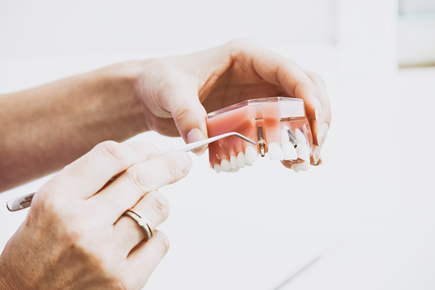
Those of you who are anticipating serious dental work look forward to getting it over and done with. It’s often time-consuming and costly, no matter how comfortable you feel at the dentist. Deciding between a dental bridge or implant makes a difference not only in the procedure itself but in the results you’ll have.
Implant or Dental Bridge: The Pros and Cons of Both
Whether you are leaning toward a dental bridge or implant, you should know about the pros and cons associated with each procedure. Let’s take a look at each in detail.
Dental Bridges
Dental bridges came about first and are still more popular than the more recently invented dental implants. A bridge consists of a minimum of three dental crowns connected together to fill in the space created by the missing tooth. That means you’ll have two or more crowns attached to surrounding teeth, plus another crown or false tooth in the empty space, just meeting the gumline.
The false tooth is a pontic while the anchoring crowns are abutment teeth. Traditionally, pontics have been made from porcelain, gold, zirconia, and metal alloys. The dentist has to shave or file down the healthy neighboring teeth to ensure enough space for alignment and surface area for a strong bond.
Since it’s just bridging the gap, it doesn’t make for very strong biting or chewing and ideally is placed in an area of the mouth that can rely more on jaw strength or which the patient does not use much for eating hard foods.
There is an alternative to this traditional bridge and it’s known as the Maryland or resin-bonded bridge. The pontic contains “wings” on either side which are attached using a composite resin cement. It is less stable than the traditional bridge, making it easy to remove, clean, and reattach. It also requires far less alteration of neighboring teeth.
- Pros: A bridge gives a natural appearance. The relatively simple procedure is fast, affordable, and low-risk. It’s covered by most insurance plans, and requires only 2-3 visits over a few weeks. It’s good for people with neighboring teeth containing large fillings or needing crowns or caps.
- Cons: It needs replacement every 5-7 years. The alteration of the natural neighboring teeth is irreversible and increases the risk of cavities and decay, as well as the need for a root canal treatment. You need a special floss and brush to clean it.
Dental Implants
Dental implants have made wonderful progress, although they’re not as widespread as bridges just because they’re rarely covered by insurance and are considered cosmetic. Patients tend to get implants when they’re missing more than one tooth, as an implant provides strength and structure and doesn’t require the support of neighboring teeth.
It involves a titanium rod post placed into the bone where the missing tooth used to be. An abutment is then attached to the post, followed by a crown. Dental implants can be used on their own or as part of an implant-supported bridge.
The titanium naturally fuses with your jawbone (known as osseointegration) and is strong enough to resist decay and gum problems. It’s ideal to have an implant soon after a tooth extraction; otherwise, additional work may need to be done before an implant procedure can begin, such as a bone graft.
- Pros: An implant lasts over 15 years! The procedure results in very little to no gum or bone loss and alteration of surrounding teeth, while the implant itself looks great. You eat, brush, and floss normally.
- Cons: It requires multiple visits over 3-6 months while osseointegration takes place. It is rarely covered by insurance, although the procedure has multiple steps and can therefore be budgeted by the patient.
Contact Us for Additional Details
Contact our Grosse Pointe dental office for more information on our services or to learn if a dental bridge or implant is more ideal for you. We can be reached through our Fisher Pointe Dental website or by phone at (313) 882-1490.
